
Hydraulic engineering
-
The proposed research aims to investigate the influences of temperature on the water retention behaviour of deformable unsaturated soil. Volume change caused by temperature variation will be taken into consideration. This research will produce a better understanding and interpretation of thermal effects on SWCCs by providing experimental results for deformable unsaturated soils.
 118p
118p  runthenight07
runthenight07
 01-03-2023
01-03-2023
 6
6
 3
3
 Download
Download
-
Research objectives: To find scientific solutions for urban drainage issues and to improve river and pipe hydraulic coupling model for suitable urban application under specific conditions of strong tidal impact, heavy rainfall and rapid urbanization in Viet Nam.
 25p
25p  change03
change03
 06-05-2016
06-05-2016
 41
41
 3
3
 Download
Download
-
Average depth model has a variety of applications in hydraulic engineering, especially in applications that flow depth is much smaller than the width of the flow. In this method the vertical variation is negligible and the hydraulic variables average integrated from channel bed to the surface free for the vertical axis. in equations arising management, pure hydrostatic pressure is assumed that not really valid in the case of flow in the bed is curved and can not be described curvature effects of the bed.
 127p
127p  gauhaman123
gauhaman123
 17-11-2011
17-11-2011
 105
105
 16
16
 Download
Download













